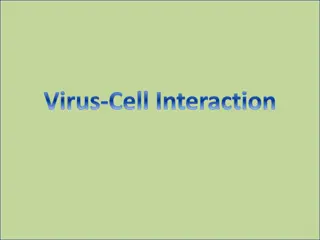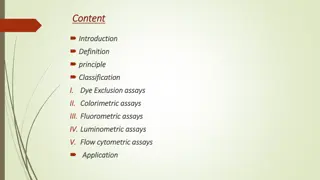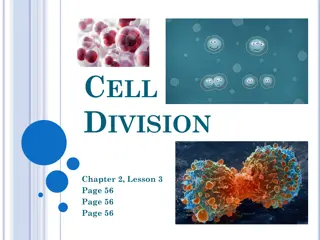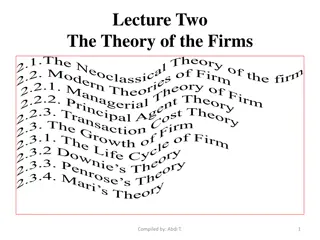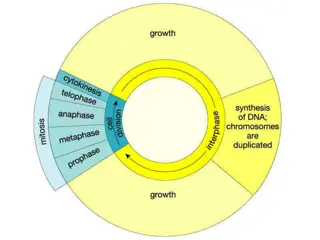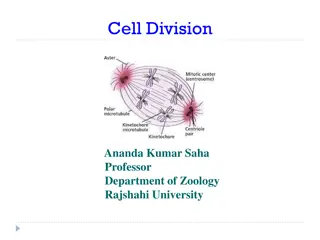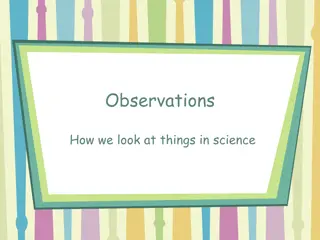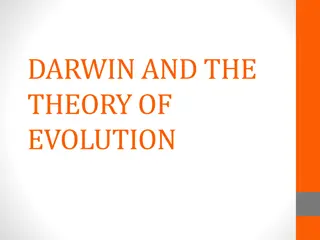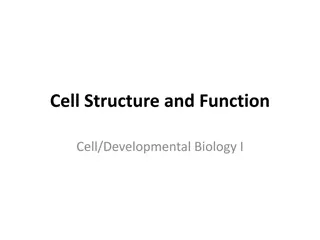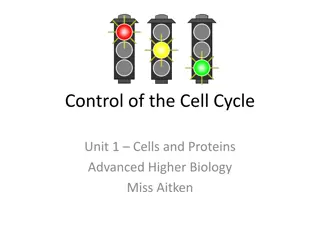Evolution of Cell Theory: From Observations to Modern Understanding
Robert Hooke and Robert Brown made key observations leading to the cell theory, while M.J. Schleiden, Theodore Schwann, and Rudolf Virchow developed the foundational principles. The modern cell theory expanded to include energy flow, heredity, and cell composition. Protoplasm theory highlighted the significance of protoplasm in cellular activities, ultimately defining the essence of life at the cellular level.
Download Presentation

Please find below an Image/Link to download the presentation.
The content on the website is provided AS IS for your information and personal use only. It may not be sold, licensed, or shared on other websites without obtaining consent from the author.If you encounter any issues during the download, it is possible that the publisher has removed the file from their server.
You are allowed to download the files provided on this website for personal or commercial use, subject to the condition that they are used lawfully. All files are the property of their respective owners.
The content on the website is provided AS IS for your information and personal use only. It may not be sold, licensed, or shared on other websites without obtaining consent from the author.
E N D
Presentation Transcript
CELL THEORY & TYPES OF CELLS
Robert Hooke -1665 observed the slices of cork tissue under compound microscope He saw honey comb like arrangement composed of small compartments. He coined the term cell for individual units
Robert Brown- 1831 observed a spherical body in each cell and called it as nucleus
CELL THEORY M.J .Schleiden and Theodore Schwann concluded that all living tissues-plant and animals are composed of individual cellular units and they proposed the cell theory Cell theory states that all organisms are composed of one or more cell and The cell is the structural and functional unit of the life
THREE TENETS TO THE CELL THEORY Rudolf Virchow states that a new cell can arise only by the division of a pre-existing living cell The three tenets to the cell theory are as described below: 1. All living organisms are composed of one or more cells. 2. Thecell is the basic unit of structure and organization in organisms. 3.Cells arise from pre-existing cells.
MODERN THEORY- CELL THEORY Energy flow occurs within cells Heredity information (DNA) is passed on from cell to cell All cells have the same basic chemical composition
PROTOPLASM THEORY Proposed by Hertwig in 1892 It states that the cell contains a viscous,colourless,translucent,col loidal susbstance called protoplasm Protoplasm means first substance
The term protoplasm was coined by Purkinje in 1840 Protoplasm is also called substance of life, or physical basis of life
Protoplasm shows all the activities like metabolism, movement , growth homeostasis, reproduction etc As long as protoplasm carries metabolic activities it is alive. The moment activities stop, protoplasm no longer live and soon disintegrates
GERM PLASM THEORY oProposed by August Weismann in 1892 oThe body of organism is formed of two types of cells namely somatic cells and germ cells oCytoplasm present in the somatic cells is called somatoplasm and in germ cells is called germplasm
Somatoplasm dies with death of animal But Germ plasm is carried to the next generation The Reproductive cells are said to be germ cells
ORGANISMAL THEORY Proposed by Laurence Picken in 1960 It states that cell is an organism Unicellular organism is small, much less differentiated mass of protoplasm Multicellular organism is large, highly differentiated mass of protoplasm
ORGANISMAL THEORY It states that cytoplasm of one cell is connected to the neighbouring cell by cytoplasmic strand called plasmodesmata This theory is not accepted because it is applicable only to plants
SHAPE AND SIZE OF CELL Shape varies depends upon the functional requirement of organism and environmental conditions irregular like amoeba, spherical, cuboidal, spindle, oval, etc
STRUCTURE OF A CELL cell has three distinct regions namely cell wall, protoplasm and vacuole cell wall and vacuoles are non- living components protoplasm is differentiated into nucleus and cytoplasm nucleus is surrounded by nuclear membrane
STRUCTURE OF A CELL cytoplasm is surrounded by cell or plasma membrane cytoplasm is differentiated into outer ectoplasm and inner endoplasm endoplasm encloses various cell organelles main cytoplasmic organelles are mitochochondria, plastids, golgi complex, endoplasmic reticulum, ribosomes, lysosomes, flagella, centroso
STRUCTURE OF A CELL plant cell has an outermost envelop called cell wall cell wall is absent in animal cell
FUNDAMENTAL PROPERTIES OF CELL 1.Membrane A cellular membrane, also called a plasma membrane, surrounds all cells. give the cell shape, and to keep the internal components confined and separate from the extracellular fluid that surrounds all cells 2.The nucleus serves two main functions. It holds the genetic material, known as deoxyribose nucleic acid or DNA. It also coordinates the activities of the cell 3.The cytoplasm serves several important cellular functions. cytoplasm provides cells with shape. The cytoplasm dissolves cellular waste products. It also facilitates movement and conducts electricity.



